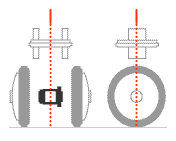|
Very wide wheels require a lot of force to drive and
turn them. Their large surface area supplies a lot of
grip and traction, but this comes at a cost.
In a straight line all of this grip is working for
you, but when performing a turn, wide wheels scrub.
Scrubbing
is caused by each side of a wide wheel trying to rotate
around a pivot point in opposing directions. (This
causes
wide tyres to leave large circular marks on the ground
– hence the term scrubbing)
A way to overcome this is to split the single wide wheel
into two narrower wheels, and place a differential between
the two. The differential compensates for each wheels
movement when the assembly is being turned.

|







